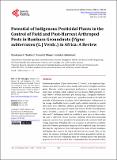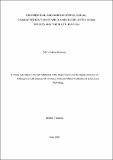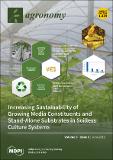| dc.description.abstract | The domestication of novel or hitherto wild food crops is quickly becoming one of the
most popular approaches in tackling the challenges associated with sustainable food crop production,
especially in this era, where producing more food with fewer resources is the need of the hour.
The crop breeding community is not yet completely unanimous regarding the importance of crop
neo-domestication. However, exploring the unexplored, refining unrefined traits, cultivating the
uncultivated, and popularizing the unpopular remain the most adequate steps proposed by most
researchers to achieve the domestication of the undomesticated for food and nutrition security.
Therefore, in the same line of thought, this paper explores the agro-morphological characteristics
of some wild Vigna legumes from an inquisitive perspective to contribute to their domestication.
One hundred and sixty accessions of wild Vigna legumes, obtained from gene banks, were planted,
following the augmented block design layout of two agro-ecological zones of Tanzania, during the
2018 and 2019 main cropping seasons for agro-morphological investigations. The generalized linear
model procedure (GLM PROC), two-way analysis of variance (two-way ANOVA), agglomerative
hierarchical clustering (AHC) and principal component analysis (PCA) were used to analyze the
accession, block and block vs. accession effects, as well as the accession × site and accession ×
season interaction grouping variations among accessions. The results showed that the wild species
(Vigna racemosa; Vigna ambacensis; Vigna reticulata; and Vigna vexillata) present a considerable variety
of qualitative traits that singularly exist in the three studied checks (cowpea, rice bean, and a landrace
of Vigna vexillata). Of the 15 examined quantitative traits, only the days to flowering, pods per plant,
hundred seed weight and yield were affected by the growing environment (accession × site effect),
while only the number of flowers per raceme and the pods per plant were affected by the cropping
season (accession × season effect). All the quantitative traits showed significant differences among
accessions for each site and each season. The same result was observed among the checks, except for
the seed size trait. The study finally revealed three groups, in a cluster analysis and 59.61% of the
best variations among the traits and accessions in PCA. Indications as to the candidate accessions
favorable for domestication were also revealed. Such key preliminary information could be of the
utmost importance for the domestication, breeding, and improvement of these species, since it also
determines their future existence—that is, so long as biodiversity conservation continues to be a
challenging concern for humanity | en_US |




